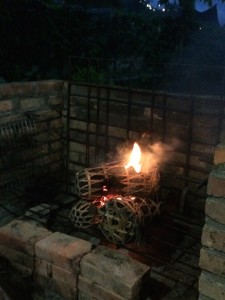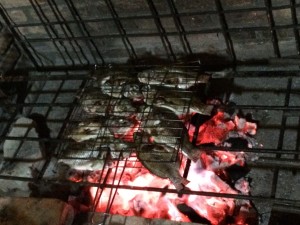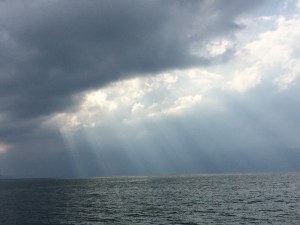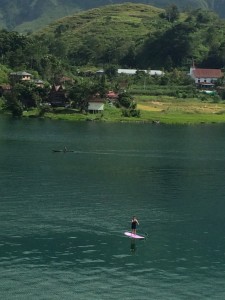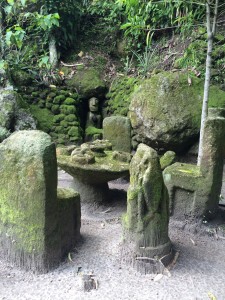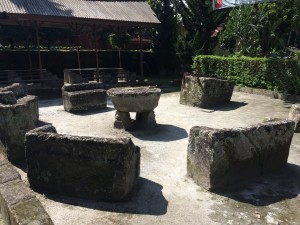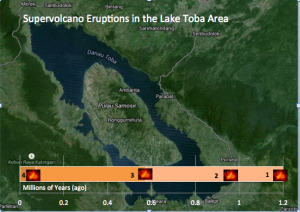At the first glimpse of Lake Toba on the winding road to Parapat, one can be forgiven for momentary confusion — is this Indonesia or Switzerland?! Dark blue waters, green hills, and an assortment of church steeples (the Bataks indigenous to the area are predominantly Christian) greet the eye. Upon reaching the ferry port at Parapat, however, you are undisputedly in Indonesia, with motor bikes, Padang canteens, and a warm and friendly chaos taking over your senses.
I am drawn to the region after no fewer than four jungle excursions in the past month, and look forward to relaxing in a more temperate climate for first time in months.
There is no dearth of accommodation in Tuk Tuk, the main tourist area on Samosir Island — an “Island within in Island” located about an hour’s ferry ride from Parapat. I’ve chosen the quirky and slightly more upscale Horas Family Home, where I am regaled by stories by the garrulous owner, indulge in not only home cooked, but also home grown/raised food (TOP RATE!!!), and float aimlessly on the lake. I also enjoy hot showers and access to my own fridge — luxuries I will never take for granted again.
This turns out to be a good choice, for even though it is officially the beginning of the dry season in Northern Sumatra — Mother Nature has other plans. I find the nightly rain drumming on the roof to be very soothing, but with the occasional afternoon squall, I also find myself grateful that there are not many more things to do in Lake Toba than relax.
On my first full day (coincidentally also the driest) I decide to venture out and explore the island. A walk around Tuk Tuk takes about an hour — but 15 minutes in I cave to the heat and decide to rent a motor bike and helmet (at, I might add, twice the rate of bikes in Lombok!) With only the most rudimentary of maps, and an occasionally confused Waze / Google Maps GPS combo, I venture out in search of the renowned “Ambarita Stone Chairs.”
While the Romans had thumbs up or thumbs down to determine gladiatorial fate, the pre-Christian Bataks had the stone chairs where they held council. Whenever an enemy was captured or a local was accused of some misdeed, the elders would invite the rulers of neighboring villages to convene and determine the fate of the victim. If deemed guilty, the poor soul would be rubbed with garlic and chilli, beheaded, and, er, savored. (If you are “lucky” you can be selected as part of a “live demonstration” on site.)
This sounded cool, if somewhat macabre. I head in the general direction over some seriously steep and rocky roads, and quickly find myself spinning in circles thanks to Waze taking me off course. (Asking for help is surprisingly useless, even in Indonesian. For every person who told me to turn left — another would tell me to turn right.). FINALLY I spot signs for “Famous Ambarita Stone Chairs”, and after parking the motorbike in a shady spot, dutifully sign the registration log and make an IDR 10,000 “donation.”
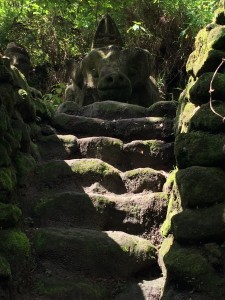 Climbing a steep, mossy (read, slippery!) staircase carved into the rocky outcrop, I snap pictures of the Batak statues and carvings along the way. Upon reaching the top, I see no stone chairs in sight. Could I have missed them? Carefully making my way down again, I see a miniature set of stone chairs that could have comfortably seated a Council of Elders — were such council comprised of children or dolls. And this looks NOTHING like the photos I’ve seen online.
Climbing a steep, mossy (read, slippery!) staircase carved into the rocky outcrop, I snap pictures of the Batak statues and carvings along the way. Upon reaching the top, I see no stone chairs in sight. Could I have missed them? Carefully making my way down again, I see a miniature set of stone chairs that could have comfortably seated a Council of Elders — were such council comprised of children or dolls. And this looks NOTHING like the photos I’ve seen online.
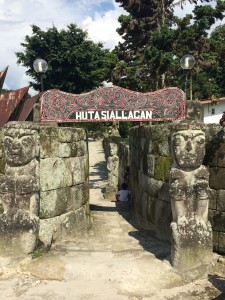 Feeling duped (but also feeling too foolish to confront the man at the registration hut), I get back on the bike and decide to wander a bit further. Down the road, I see signs for “Huta Siallagan” — the ACTUAL stone chairs. They are certainly more to scale, and an impressive sight to behold, but the fake Batak village and souvenir market somehow cheapen the overall experience. So I find my earlier irritation fading, especially considering that as part of my earlier “donation” I was given a rather cute carved keychain as a souvenir.
Feeling duped (but also feeling too foolish to confront the man at the registration hut), I get back on the bike and decide to wander a bit further. Down the road, I see signs for “Huta Siallagan” — the ACTUAL stone chairs. They are certainly more to scale, and an impressive sight to behold, but the fake Batak village and souvenir market somehow cheapen the overall experience. So I find my earlier irritation fading, especially considering that as part of my earlier “donation” I was given a rather cute carved keychain as a souvenir.
I gained three key takeaways from this little adventure (misadventure?). First, given that this was the historical highlight of Samosir, I would not feel guilty for spending the rest of my stay taking in the scenery at my own, VERY SLOW pace.
Second, even though one was officially a mistake, I was quite happy to appreciate the two different sites from an aesthetic perspective, especially when not ascribing any particular historical importance to either. Third and most importantly, I realized that it was the story, more than the site, that appealed to me. One of my favorite pastimes is to collect folk and fairy tales from around the world. So, over the next sleepy couple of days in Lake Toba, I greatly enjoyed learning two tales of creation behind this very special place.
Version 1: The Batak Legend of Samosir
Once upon a time, there was a young farmer named Toba. He lived in a fertile valley and while by far not a rich man, he was able to support himself by growing crops.
One day, Toba awoke with a craving for fish, and headed to a nearby river with his fishing pole in tow. The river was usually teeming with fish, but on that strange day, not a single one was in sight. Just as he was preparing to leave (with great disappointment) he snared a big fish. As he slowly reeled it in, he was surprised to hear a voice pleading with him to let the fish go. Looking around, he saw no one. He then realized that the fish itself was speaking to him.
Astounded, Toba released the fish back into the river. Suddenly the fish transformed into beautiful young woman. The woman explained that she was actually a princess who had been cursed to live out her life as a fish. In gratitude to the young farmer for breaking her curse, the princess said that she would happily become his wife under one condition — he must never tell a soul about her previous life as a fish. If he did not heed this condition, she warned, a terrible tragedy would befall him.
Toba and the princess were happily married, and soon after she gave birth to a baby boy, whom they named Samosir. Samosir had a tremendous appetite. In a perpetual state of hunger, he would devour all the food on the table without leaving his parents a single morsel to eat.
One day, Samosir was sent to bring food to his father who was busy working in the fields. Absentmindedly he began nibbling at the delicious meal that his mother had packed. Toba was both famished and tired after a hard day’s work, but discovered that was no food left for him to eat. In a fit of rage, he lashed out at the boy, calling him a son of a fish.
Crying, Samosir ran home and asked his mother if he really was a son of a fish. Shocked and saddened, the princess told the boy to climb the to the top of the tallest tree on the hill behind their home. Hurrying to the river bank where she and Toba first met, the princess suddenly disappeared.
The sky turned black as night, and thunder, lightning and heavy rain besieged the valley, causing a great flood. The water levels continued to rise until the valley was no more — it had turned into a large lake. The hill became an island, named after its sole survivor, Samosir. Legend has it that Samosir is the father of the Batak people of North Sumatra. Toba, the harbinger of disaster, is commemorated by the lake which today bears his name. Of the princess, sadly, nothing remains.
Version 2: Science Stuff
Lake Toba and Samosir Island were formed after the eruption of a supervolcano some 75,000 years ago. Due to its unique topology, Samosir is quite possibly the only place in the world where you can both stand on an island on an island (The island of Samosir in Lake Toba on the Island of Sumatra) and swim in a lake on a lake (Lake Sidihoni on Samosir on Lake Toba)
Quick Facts
- Lake Toba is the largest volcanic lake in the world, and is one of approximately 20 recognized “supervolcanoes” in the world.
- The lake was formed after a massive eruption approximately 74,000 years ago, believed by scientists to be the largest volcanic eruption of the past 2.5 million years
- Ash from the eruption has been found as far away as Lake Malawi, Africa
- The Toba Catastrophe Theory posits that the last eruption was so severe that it led to an ice age, and wiped out most of our prehistoric ancestors in everywhere but Africa, creating a “genetic bottleneck” explaining the origins of the human race stemming from that continent.
- However, the above theory is being increasingly discredited as new science comes to light
-
The North-South Sumatra fault line, which bisects Sumatra, runs through Mount Toba.
- In theory, any activity along this fault line could trigger another Toba eruption.
- Samosir is the largest island on an island, and the fifth largest lake island in the world
- Samosir was originally a peninsula, connected to mainland Sumatra by a small isthmus
I think both versions are pretty interesting — which one do you prefer?








